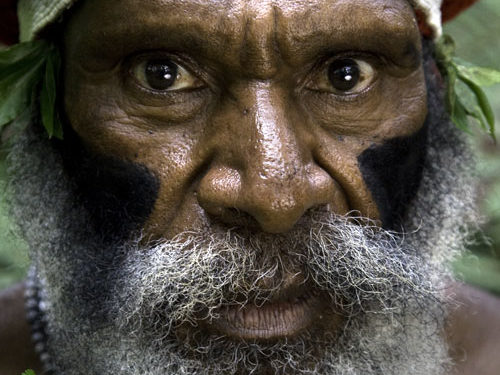The Digital Camera: Light Control

Not only does the diffuser soften the light, but it increases the size of the light source…
Professional photographers who focus on people photography and portraits never leave home without a reflector, a handheld diffuser, and a flash diffuser. I’m in that crowd. I take these accessories with me to control the light both indoors and outdoors when it’s not right, and when I simply want more creative lighting.
In the studio, pros use reflectors and diffusers in combination with accessory flash units (the kind that fit in the hot-shoe of a camera) and wireless transmitters for professional studio lighting effects. Again, I’m one of ’em.
I’m going to cover all that stuff in this column. Let’s get started.
Reflecting and diffusing light
A reflector does exactly what its name implies: it reflects light. The opening photograph for this article was taken in Papua New Guinea during one of my 2008 photography workshops. Check out the catch light in the subject’s eyes. See how his face is nicely illuminated. And note the contrast and detail in the image.
Now compare the opening image to this one. It’s the same subject, same setting, but the only difference is that in the first photograph I asked our guide to hold a reflector so that the light from the sky was reflected onto the subject’s face. The reflector made all the difference in the world, turning a flat shot into a striking shot with more detail and contrast.


Our guide holds a reflector for one of the workshop participants, Bev Sanchez. The reflector collapses and fits neatly into the tote that the guide is carrying over his shoulder.
Let’s move on to diffusers. A diffuser is made out of a translucent material that softens harsh light as it passes through. Compare these two pictures of a woman I photographed in Mongolia. I know which one you like better! It’s the softer, more flattering portrait of the woman—the one where you can better see her eyes and in which her skin is softened. For that image, I had my friend, Jack Leggett, hold a diffuser between the sun and the subject.



CREDIT: JACK LEGGETT Here, I’m demonstrating the effect of a diffuser to workshop participants.
Many choices
Diffusers and reflectors are available in all sizes and shapes, and are sold separately and in kits. Many reflectors have a gold side to bounce a warm quality of light, and a silver side to bounce a cooler and stronger quality of light.
Some kits come with a zip-on cover with a black side and a white side. Use the black side to cut down on light falling on a subject, and the white side to bounce a very soft light onto the subject.
For photographers who do mostly head and head-and-shoulder shots, small reflectors and diffusers do the job. The kit you see here, actually the Rick Sammon Light Controller and Tote from Westcott www.fjwestcott.com, includes a handheld diffuser, a reflector, and a diffuser that attaches directly to a flash via supplied Velcro.

I use the diffuser attached to the flash all the time because I don’t want my flash pictures to look like harsh flash pictures, which was one of my goals when I photographed this “warrior” in Mongolia. Not only does the diffuser soften the light, but it increases the size of the light source, which is beneficial when taking group photographs. Compare these photos to see the big benefit of using a flash with a diffuser outdoors.


For professional jobs, larger reflectors and diffusers are available. As the size of the reflector increases, the size of the reflected light source increases. Large diffusers are used for full-length portraits and when two or more people are in the photograph. During this photo shoot at Lake Mead, Arizona, our team of photographers used a large reflector to illuminate this model.


Reflectors and diffusers can be used in the professional and home studio as well. I use stands and arms from Westcott to support my reflectors and diffusers, and stands and flash holders from Bogen (www.bogenimaging.com) to support my flash units.

Using flash with reflectors and diffusers
When you fire a flash into a reflector, you increase the size of the light source tremendously for more even lighting. Fire it through a diffuser, and again you increase the size of the light source—in this case for beautiful soft lighting.
To fire the flash units off-camera, you’ll need a wireless infrared (IR) transmitter, which fits into the hot-shoe of your camera. With an IR transmitter, you can fire several remote flashes at once, creating true professional-quality results.
When using a flash with a reflector or diffuser, keep the flash at least 3′ away from the reflector or diffuser. At that distance, the size of the light source is increased. Any closer and you’re not getting the full benefit of the reflector or diffuser because you’re not fully increasing the size of the light source. This is an important tip.
Portraits
Here’s a portrait of Emmy Award winner David Leveen taken with a three-flash, two-reflector set up triggered by a wireless transmitter. I positioned one flash and reflector setup to my left to illuminate his face, and placed another slightly behind him and to my right to create side lighting. Then I positioned a single flash unit (with no reflector) directly behind him for what’s called “Hollywood lighting.”

For this portrait of my friend Kristen, I used my accessory flash units as my light sources, firing them into and through my reflectors and diffusers. I also had her hold a gold reflector on her lap, which bounced light onto her face, filling in shadows that were created by overhead lighting.

Reflectors and diffusers can be used together, both indoors and out. And they can be positioned in many different locations around a subject. Experiment and have fun! Play with light.
ALL IMAGES BY RICK SAMMON UNLESS OTHERWISE NOTED

